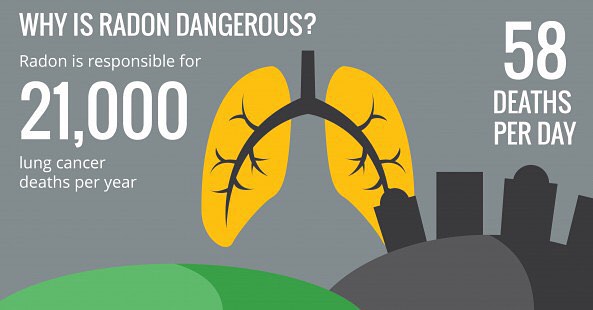The EPA recommends that all homes be tested for radon, since radon is the second leading cause of lung cancer. Alban home inspectors are certified and utilize state-of-the-art testing equipment to ensure our clients receive accurate and reliable test results.
Unfortunately, Alban Inspectors have conducted several radon tests in homes in which a member of the seller’s family was suffering from lung cancer. In each case, the level of radon gas measured in the home exceeded the EPA recommended remediate level of 4 picocuries per liter of air. Was this a coincidence? Actually, there is scientific proof that radon gas is a human lung carcinogen. Prolonged exposure to high levels of radon gas can cause lung cancer. Millions of homes and buildings contain high levels of radon gas.
As a means of prevention, the American Lung Association, National Cancer Institute, EPA and the Office of the Surgeon General recommend that all homes be tested for radon below the third floor. Because radon is invisible and odorless, a simple test is the only way to determine if a home has high radon levels. EPA recommends mitigating homes with high radon levels and there are straight-forward reduction techniques that will work in virtually any home.
An estimated cost for a radon mitigation system is between $1,000 and $1,500. If you do not make a radon test part of the inspection contingency, you will not have the opportunity to negotiate with the seller for installing a mitigation system. Radon is estimated by the EPA to cause thousands of deaths each year.
Where is Radon?
Radon has been found in homes in every state. It can pollute any home, whether new construction or an existing home, home with a walkout basement, a crawl space or slab-on-grade. All homes are susceptible.
How does Alban test?
Alban uses an ion chamber radon testing device for short-term real estate transactions, called E-Perm. This is a 48 hour test. The chamber has an electrically charged sensor to measure the breakdown of radioactive radon into inert lead molecules. Upon completion of the test, your inspector determines the level of radon and faxes the complete, personalized written test report to both you and your Realtor. It is the most versatile radon measurement system available, able to conduct tests in a wide range of environmental conditions. Ion chambers are true integrating devices, meaning that they do not bias their results toward the end of a measurement period. Long-term testing (defined as over 90 days) for homeowners is also available utilizing similar equipment.
Is Remediation Difficult?
No, remediation is cost efficient and relatively easy to install by a professional contractor. Should the radon average for the 48-hour test period be in excess of 4.0 pico/Curries per liter, a vacuum fan system piped from the sub-slab airspace can be installed to reduce the gas pressures under the slab and thereby control the level of radon in the house. The cost is typically $1,000 to $1,500.
For more information visit these informational web sites:
3 Radon Myths Debunked
One of the most important parts of a home inspection is radon testing. Radon is a colorless, odorless, tasteless gas that can seep into the home through cracks in the foundation, pipes and construction joints. The only way to know if a home has been compromised by radon is to specifically test for it. Radon is dangerous, and a home left untreated can result in serious health issues and even death. Keep the following three myths in mind when thinking about radon in your home:

Radon testing is difficult, expensive and time consuming. Radon testing is inexpensive when compared to the numerous health costs and home damage that can occur if left untreated. Although it can be tested by homeowners, homebuyers should call in a professional representing your best interests.
Radon only affects older homes. Radon can seep into any home, drafty, sealed, old or new. Local subsoil conditions, geology, construction materials and home type are only a few factors that may cause radon.
If your neighbor doesn’t have radon, you won’t either. Radon varies home to home and can happen in your home without affecting those around you.

